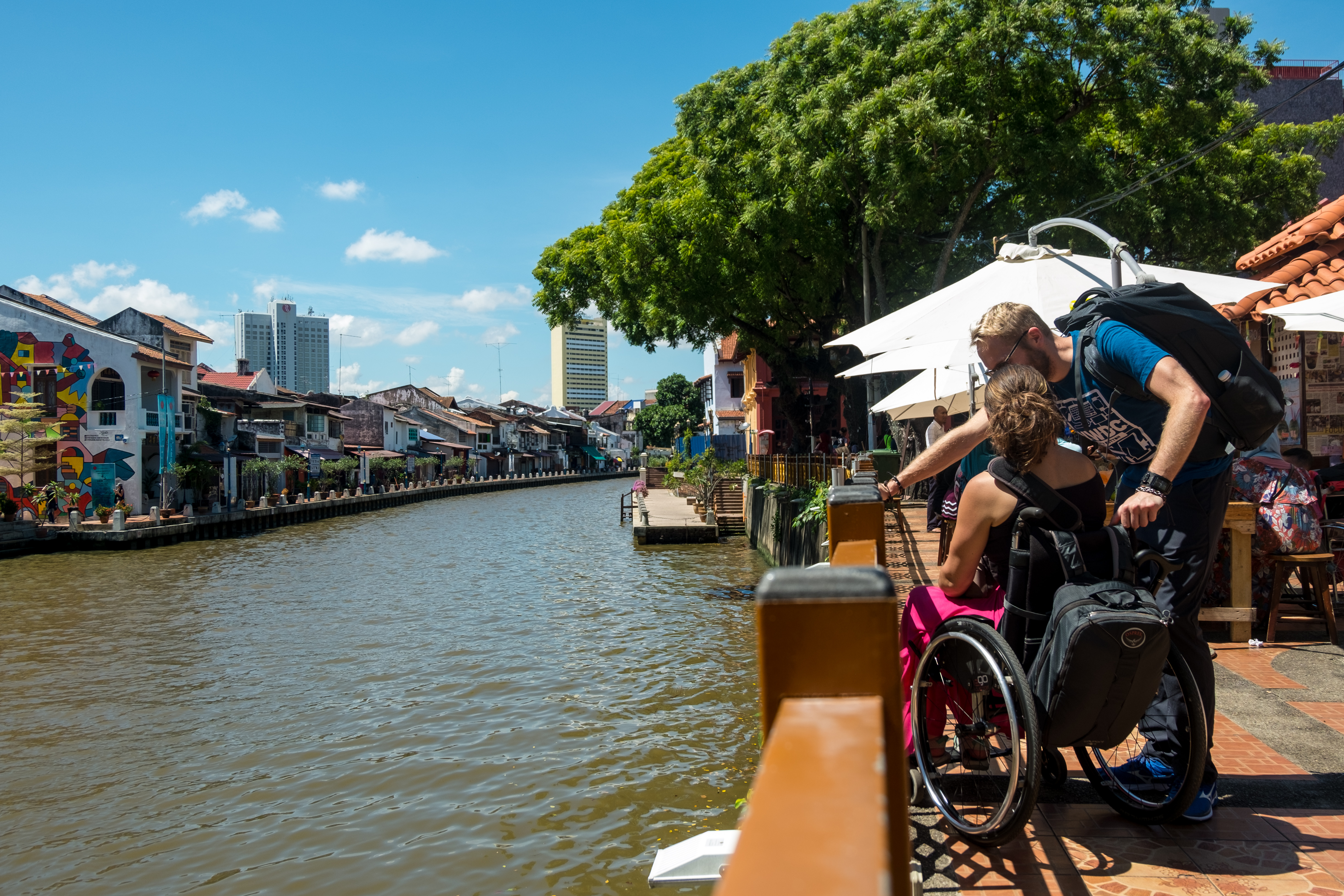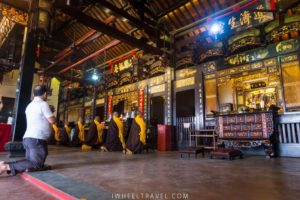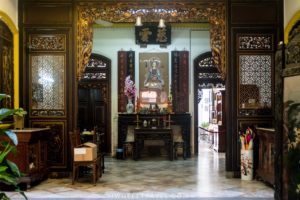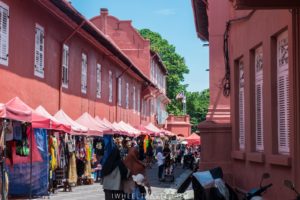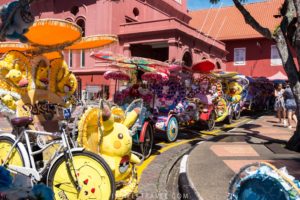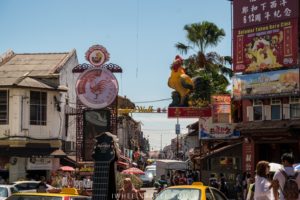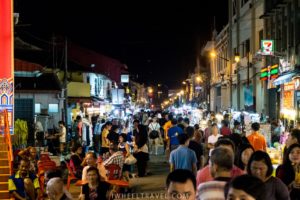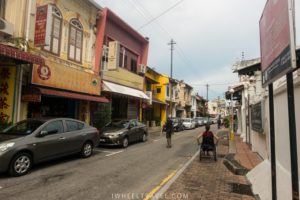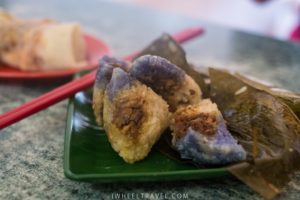A week-end in Malacca
Located between Kuala Lumpur and Singapore, Malacca used to be one of the biggest south-east Asia harbour. Thanks to its strategic location, Portuguese, British, Chinese and many more left a mark on this city. Over a week-end, we went there to have a glimpse of this majestic past, listed as a UNESCO World Heritage site since 2008.
Sommaire
Historic streets and cultural diversity
To see this multicultural past, you just need to wander in the small streets of the city. Some neighbourhoods have a strong Chinese influence while some others remind me much more of Europe. All those cultures mingle and co-exist. In « Jalan Tokong » street you can spot a mosque, a buddhist temple and a hindou temple just few meters from one another.
In « Jalan Tun Tan Cheng Lock » and its surrounding streets you can clearly see the Chinese heritage. Red lanterns and Chinese glyphs are visible on the front door of the house. Few blocks down, the smell of incense get to our nose: it’s time for the prayer at the buddhist temple.
We contemplate the ceremony before heading toward « Baba et Nyonya Heritage museum », to learn more about the Peranakan culture. This is the culture of those who decent from a Chinese and Malay marriage. Men from this union are called « Baba » and women « Nyonya ». The museum is named after them, which is located inside a Peranakan Clan house. We did a guided tour, included in the entrance fee, and I found it rather interesting. We admired stunning furnitures and decorations, made out of dark wood coated in gold. Moreover, we learnt a lot about Babas and Nyonyas daily life, on their children, their weddings, their celebrations or even on their death and grieving traditions. Unfortunately, the museum is not wheelchair accessible. There are steps at the entrance and the visit includes first and second floor, only accessible by steep stairs.
When strolling on « Dutch Square » and its surroundings, we can easily feel Malacca’s colonial past. The architecture, for once, is different. Gone are Chinese roofs, and welcome European red brick buildings, like the city hall « Stadthuys ». There is even a fountain in the middle of the square, a small fortress in ruin « A Famosa », and the catholic church of Francis Xavier a bit further. Sadly, wheelchair user will not be able to see some historic buildings, like the ruins of Saint Paul church, since they are on a top of a hill.
But the worst might not be the lack of accessibility. Indeed, globalisation is also visible in Malacca. Around the historic square, there are many trishaws to transport tourists. At first it is funny to see those little vehicles. They are bright yellow, pink or blue, with kid’s favorite characters. But you do get tired of them quite fast. Seeing Pikachu, Hello Kitty, Frozen and Minions around every corner ruin a bit the historic aspect of the city. Especially when they play popular song extremely loud! Thankfully we didn’t see any on the other side of the river.
« Jonker walk », the touristic street
Jonker walk, located in the center of Chinatown, is the touristic street of Malacca. You will find many small shops one after another selling food, souvenirs and clothing. Not very authentic.
While I couldn’t resist tasting some sweet snacks, I was not impressed by the souvenirs and the clothing. Most of them seemed fake « local » goods and shops were full of tourists. Therefore It was difficult for me to go in these small aisles in my wheelchair. Moreover we still had all our backpacks, sweating under the scorching sun, as we just arrived.
But I really enjoyed rediscovering this street at night, during the market. It is held every Friday to Sunday. Even if the street is even more crowded than during the day, there is a different feel to it. Locals and tourists, pressed against each other, are scouting for savoury or sweet treats on the hawkers on each side of the street. Pastry puffs filled with coconuts, almonds or barbecue pork, pasteis de nata (not as good as in Porto), meat skewers, pancakes and so on… The hardest is to choose!
Malacca in a wheelchair
Accessibility there is not perfect. Sidewalks come in different width, there is not always a manageable curb-cut and if you success to get on it, you will probably be facing a lamp post, a trash bin or another object obstructing the way. There are also grids on the floor where the wheels can get stuck. So once more, you will end up often rolling on the road. As a matter of fact, some streets in Chinatown have no sidewalk at all. Circulation can be heavy, and while it can be unsettling, everything went quite well.
Access to the shops are often difficult as you will need to climb of the sidewalk. In very rare cases, there are ramps to go inside. As a side note, the tourist office is not wheelchair accessible and, unlike Kuala Lumpur, there is no mark of the ground nor sound alert to guide visually impaired people.
Let’s finish on a positive note. You will find a disabled parking space and a disabled toilet (lateral transfer impossible) in the middle of Jonker street, next to the statue of a bodybuilder.
Where to eat in Malacca?
Like everywhere in Malaysia, you can find plenty of delicious food around. Here some addresses to help you choose:
- Poh Piah Lee: 14 Jalan Kubu. While it doesn’t look like much from the outside, this restaurant deserve a try if you are after cheap Peranakian food. Blue dumplings (because of the local blue flower they use as an ingredient) and popiah are very good. Popiah is like a spring roll, wrapped inside a thin pancake instead of rice paper.
- Restoran Selvam: 3 Jalan Temenggong. A must if you crave for Indian food and want to eat with your fingers on a banana leaf. It’s delicious, cheap, with plenty of vegetarian options. Bonus: there is a ramp to access the sidewalk and only one step to go inside the restaurant.
- Jonker Food Avenue: Small food market in the center of Jonker street. Many local dishes are available here. I went for a Mee Nyonya Laksa, a noodle soup with tofu, egg and surimi. Quite filling and an explosion of taste: it is probably the hottest and spiciest dish I ate during our five weeks trip in Malaysia! Not for the faint of heart!
-
And of course, don’t miss the Jonker street night market.
If you would like to have more information about travelling in this country you can read about all our travel destinations in Malaysia and their wheelchair accessibility and discover our travel budget and itinerary.
Did you like this post? Feel free to check out my Patreon page to see how you can support the creation of new ones and be a part of iwheeltravel!
And of course, you can share, like and subscribe, to be aware of the lastest posts.

